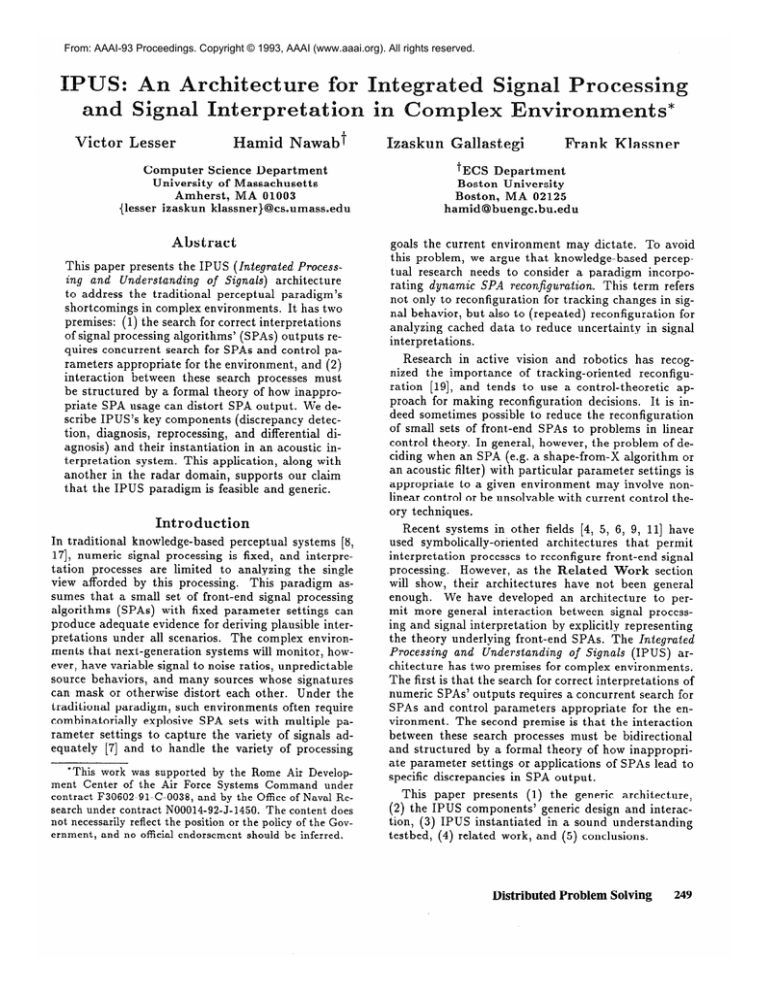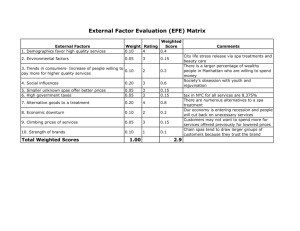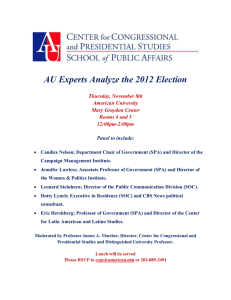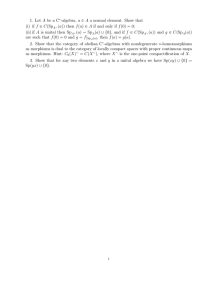
From: AAAI-93 Proceedings. Copyright © 1993, AAAI (www.aaai.org). All rights reserved.
Victor
Lesser
Hamid
Nawabt
Computer
Science Department
University
of Massachusetts
Amherst,
MA 01003
{lesser izaskun klassner}@cs.umass.edu
Abstract
This paper presents the IPUS (Integratecl Processing and Understanding of Signals) architecture
to address the traditional
perceptual paradigm’s
shortcomings in complex environments.
It has two
premises: (1) the search for correct interpretations
of signal processing algorithms’ (SPAS) outputs requires concurrent search for SPAS and control parameters appropriate for the environment, and (2)
interaction
between these search processes must
be structured by a formal theory of how inappropriate SPA usage can distort SPA output. We describe IPUS’s key components (discrepancy detection, diagnosis, reprocessing,
and differential diagnosis) and their instantiation
in an acoustic interpretation
system. This application, along with
another in the radar domain, supports our claim
that the IPUS paradigm is feasible and generic.
Introduction
In traditional
knowledge-based
perceptual systems [B,
171, numeric signal processing is fixed, and interpretation processes are limited to analyzing the single
view afforded by this processing.
This paradigm assumes that a small set of front-end signal processing
algorithms
(SPAS) with fixed parameter settings can
produce adequate evidence for deriving plausible interpretations under all scenarios.
The complex environments that next-generation
systems will monitor, however, have variable signal to noise ratios, unpredictable
source behaviors, and many sources whose signatures
can mask or otherwise distort each other. Under the
traditional paradigm, such environments often require
combinatorially
explosive SPA sets with multiple parameter settings to capture the variety of signals adequately [7] and to handle the variety of processing
*This work was supported
by the Rome Air Development Center of the Air Force Systems Command
under
contract F30602-91-C-0038,
and by the Office of Naval Research under contract N00014-92-J-1450.
The content does
not necessarily reflect the position or the policy of the Government, and no official endorsement
should be inferred.
Pzaskun Gallastegi
Frank Klassner
*ECS Department
Boston University
Boston,
MA 02125
hamid@buengc.bu.edu
goals the current environment
may dictate.
To avoid
this problem, we argue that knowledge-based
perceptual research needs to consider a paradigm incorporating dynamic SPA reconfiguration.
This term refers
not only to reconfiguration
for tracking changes in signal behavior, but also to (repeated) reconfiguration
for
analyzing cached data to reduce uncertainty
in signal
interpretations.
Research in active vision and robotics has recognized the importance
of tracking-oriented
reconfiguration [19], and tends to use a control-theoretic
approach for making reconfiguration
decisions.
It is indeed sometimes possible to reduce the reconfiguration
of small sets of front-end SPAS to problems in linear
control theory. In general, however, the problem of deciding when an SPA (e.g. a shape-from-X
algorithm or
an acoustic filter) with particular parameter settings is
appropriate to a given environment
may involve nonlinear control or be unsolvable with current control theory techniques.
Recent systems in other fields [4, 5, 6, 9, 111 have
used symbolically-oriented
architectures
that permit
interpretation
processes to reconfigure front-end signal
processing.
However, as the
elated Work section
will show, their architectures
have not been general
enough.
We have developed an architecture
to permit more general interaction
between signal processing and signal interpretation
by explicitly representing
the theory underlying front-end SPAS. The Integrated
arProcessing and Understanding of Signals (IPUS)
chitecture has two premises for complex environments.
The first is that the search for correct interpretations
of
numeric SPAS’ outputs requires a concurrent search for
SPAS and control parameters
appropriate
for the environment.
The second premise is that the interaction
between these search processes must be bidirectional
and structured by a formal theory of how inappropriate parameter settings or applications of SPAS lead to
specific discrepancies in SPA output.
This paper presents (1) the generic architecture,
(2) the IPUS components’ generic design and interaction, (3) IPUS instantiated
in a sound understanding
testbed, (4) related work, and (5) conclusions.
Distributed Problem Solving
249
The Generic
IPUS
Architecture
Before describing IPUS we must first discuss SPAS,
the basic means for analyzing environmental
signals.
When applied to a signal, an SPA instance produces
correlates,
which serve as evidence for hypothesizing
features of objects (e.g. sounds or physical objects).
An SPA instance is specified by values for a generic
SPA’s parameters, and these values induce capabilities
or limitations
with respect to the scenario being monitored. We use “SPA” to refer to SPA instances.
Consider the Short-Time
Fourier Transform
(STFT)
[15]
in the acoustic domain. An STFT instance has particular values for its parameters,
such as analysis window
length, frequency-sampling
rate, and decimation factor
(consecutive
analysis windows’ separation).
Depending on a scenario’s spectral features and their timevariant nature, these parameter values increase or decrease the instance’s usefulness in monitoring the scenario. Instances with large window lengths provide fine
frequency
resolution for scenarios containing
sounds
with time-invariant
components,
but at the cost of
poor time resolution for scenarios containing sounds
with time-varying components.
Figure la shows the generic IPUS architecture.
Two
types of signal interpretation
hypotheses are stored on
the hierarchical
blackboard:
current signal data’s interpretations
and expectations
about future data’s interpretations.
The design of IPUS assumes that signal data is analyzed in blocks. IPUS uses an iterative process to converge to appropriate
SPAS and interpretations.
The
following is a summary (see Architecture
Components
and [12, 141 for more detail).
For each data
block, the loop starts by processing the signal with an
initial SPA configuration.
These SPAS are selected not
only to identify and track the objects most likely to
appear, but also to provide indications
of when less
likely or unknown objects have appeared. In the next
loop step, a discrepancy detection process tests for discrepancies between the correlates of each SPA in the
current configuration
and expectations
based on (1)
object models, (2) th e correlates of other SPAS in the
configuration,
and (3) application-domain
signal characteristics.
These comparisons
may occur both after
SPA output is generated and after interpretations
are
generated.
If discrepancies
are detected, a diagnosis
process then attempts to explain them in terms of a set
of distortion hypotheses.
This diagnosis uses the formal theory underlying the signal processing. The loop
ends with a signab reprocessing stage that proposes and
executes a search plan to find a new front-end (i.e. a set
of SPAS) to eliminate or reduce the hypothesized distortions.
After the loop’s completion, if there are any
similarly-rated
competing top-level interpretations,
a
differential diagnosis process selects and executes a reprocessing plan to detect features that will discriminate among the alternatives.
IPUS is intended to integrate the search for interpre-
250
Lesser
tations of SPA correlates with the search for SPA parameter values appropriate to the scenario. In complex
environments we argue that these searches must interact bidirectionally
under the guidance of a domain’s
formal signal processing theory- The dual search in the
framework becomes apparent with the following observations.
Each time data is reprocessed,
whether for
disambiguation
or distortion elimination,
a new state
in the SPA search space is tested for how well it eliminates distortions.
The measurement of distortion elimination or disambiguation
assumes that the system’s
current state in the interpretation
space matches the
scenario being observed. Failure to remove a hypothesized distortion after a bounded search in the SPA
space will lead to a new search in the interpretation
space.
This occurs because the diagnosis and reprocessing results represent attempts at justifying the assumption that the current interpretation
is correct. If
either diagnosis or reprocessing fails, there is a strong
likelihood that the current interpretation
is not correct and a new search is required-in the interpretation
space. Furthermore,
the results of failed reprocessing
can constrain the new interpretation
search by eliminating from consideration
objects with features that
should have been found during the reprocessing.
We designed IPUS to serve as the basis of perceptual systems that can manage their interpretations’
uncertainty
levels. Therefore,
we had to provide the
architecture’s
control framework with a way to represent factors that affect interpretations’
certainties.
The control framework also had to support
context-sensitive focusing on particular uncertainties
in order
to control engagement
and interruption
of the architecture’s reprocessing loop.
For these reasons, IPUS uses the RESUN [3] framework to control knowledge source (KS) execution.
This
framework supports the view of interpretation
as a
process of gathering evidence to resolve hypotheses’
sources of uncertainty
(SOUs).
It incorporates
a language for representing SOUs as structures which trigger the selection of appropriate
interpretation
strategies. Problem-solving
is driven by information
in the
problem solving model, which is a summary of the current interpretations
and the SOUs associated with each
one’s supporting hypotheses.
An incremental,
reactive
planner maintains control using control plans and focusing heuristics. Control plans are schemas that define the strategies and SPAS available to the system
for processing and interpreting
data, and for resolving
Focusing heuristics
are
interpretation
uncertainties.
context-sensitive
tests to select SOUs to resolve and
processing strategies to pursue.
Architecture
Components
This section provides detailed, yet generic, descriptions
of the key architectural
components.
Our focus is on
the three roles a domain’s formal signal processing theory can play in guiding interpretation
and processing in
Figure
1: la shows the generic
Solid arrows
indicate
SOUs (discrepancies)
architecture
level,
dataflow
architecture,
relations.
in the problem
for an application
not just
IPUS
Dotted
solving
lb shows the architecture
arrows
indicate
plans
model that were selected
is shown in parentheses
instantiatedfor
that the planner
by the focusing
in 1 b. Reprocessing
the sound understanding
can pursue
heuristics.
plans can produce
when
Knowledge
SPA output
trying
testbed.
to reduce
to instantiate
the
at any abstraction
the lowest.
a complex environment:
(1) providing methods to determine discrepancies between an SPA’s expected correlate set and its computed correlate set, (2) defining
distortion processes that explain how discrepancies between expectations
and an SPA’s computed correlates
result when the SPA has inappropriate
values for specific parameters, and (3) specifying strategies to reprocess signals so that distortions are removed or ambiguous data is disambiguated.
We relate a signal processing theory to SPAS and
their interaction with the environment using SPA processing models. An SPA processing model describes
how the output of the SPA changes when one of its
control parameters
is varied while all the others are
held fixed.
SPA processing models serve as the basis for defining
how the parameter settings of an SPA can introduce
distortions into the SPA’s computed correlates. These
distortions cause SPA output discrepancies.
Consider
an SPA processing model corresponding to the STFT’s
WINDOW-LENGTH
parameter and how this model
Assume that an
can be used to define distortions.
STFT with an analysis window of length VV is applied
to a signal sampled at rate R. If the signal came from a
scenario containing two or more frequency tracks closer
than R/W, Fourier theory predicts
appear as one track in the STFT’s
iscrepancy
that the tracks will
correlates.
Detection
Discrepancy detection is crucial to IPUS’s iterative approach.
Its inclusion in the IPUS loop relies on several observations.
An SPA’s correlates can be compared with expectations
based on object models or
on a priori environment constraints such as maximum
bounds on sounds’ rate of temporal
change in frequency. Most importantly,
a domain’s signal processing theory can specify how one SPA’s correlates for a
context-independent
feature can serve as the basis of
expectations
for another SPA’s output correlates.
This
specification
can serve to check an SPA’s appropriateness to the environment.
It can also serve to decide
where to selectively apply another SPA in the signal
data stream to obtain correlates for context-dependent
features. For example, in the acoustic domain a timedomain energy tracking algorithm can detect impulsive sources whose short-duration
frequency
components might be smoothed to indetectability
in the output of an STFT with a wide analysis window. Thus,
the energy algorithm can serve as a standard against
which STFT output can be compared.
DistributedProblem Solving
251
We categorize discrepancies in focusing heuristics
diagnostic consideration
in th .e following order:
for
faults
A discrepancy detected between an SPA’s correlates and correlates from other SPAS applied to
the same data.
In [2] we discuss several fault discrepancy detection algorithms used in the sound understanding testbed. Faults are considered for diagnosis first since inconsistency
among the outputs of
two or more SPAS within a front-end almost always
indicates a front-end’s inappropriate
application.
violations
A discrepancy detected between an SPA’s
correlates and environment
constraints.
Violations
are ranked second for diagnosis since they reflect a
comparison between only one SPA’s output and domain characteristics
that may be incompletely specified.
conflicts
A discrepancy between an SPA’s correlates
and the output expected based on previous highlevel interpretations.
Conflicts are ranked third for
diagnosis since they reflect a comparison
between
SPA output and interpretations
which may not be
accurate even if they are based on appropriatelyprocessed data.
In IPUS, conflict discrepancy detection is distributed
among all KSs that interpret lower-level data as higherlevel concepts.
Each such KS checks if any data can
support a sought-after
expectation.
If no such data or
only partially supportive data is found, the KS records
this fact as an SOU in the problem solving model, to
be resolved at the discretion of the focusing heuristics.
Once a data block’s front-end processing is completed,
a discrepancy detection KS checks if SPA correlates are
consistent with each other, testing for violations and
faults defined by the system designer.
An important consideration in discrepancy detection
is that expectation
hypotheses are sometimes only expressible qualitatively,
as in the example, “During the
next 400 to 800 msec, a sinusoidal component currently
at 1200 Hz will shift to a frequency between 1700 and
2000 Hz.”
Thus, our testbed discrepancy
detection
components use a range calculus similar to Allen’s [l]
to specify discrepancies.
Discrepancy
Diagnosis
The discrepancy diagnosis KS is included to take advantage of the fact that a signal domain’s SPA processing models can predict the form of an SPA’s correlates
when the SPA’s parameter values are appropriate
OT
inappropriate
to the current scenario.
The KS models this knowledge in a database of distortion operators.
When an operator is applied to
a description
of undistorted
SPA output, it returns
the output with the operator’s distortion introduced.
The KS uses these operators in a means-ends analysis framework [16] to “explain” discrepancies between
the expected form of an SPA’s correlates and the actual form of the SPA’s computed correlates.
There are
252
two inputs for this KS: an initial state representing the
expected correlates’ form and a goal state representing the computed correlates’ form.
The formal task
of diagnosis is to generate an operator sequence mapping the initial state onto the goal state.
Note that
there is a difference between discrepancies
and distortions. Distortions are used to explain discrepancies.
It
is also possible for several distortions
to explain the
same kinds of discrepancies.
In the IPUS
Instantiation section we will see how a “low frequency resolution” distortion explains ‘missing’ track discrepancies.
The KS’s search for a distortion operator sequence
is iteratively carried out using progressively more complex abstractions
of the initial and goal states, until a
level is reached where a sequence can be generated using no more signal information than is available at that
level. Thus, the KS mimics expert diagnostic reasoning
in that it offers simplest explanations
first [18]. Once
a sequence is found, the KS enters its verify phase,
“drops” to the lowest abstraction
level, and checks
that each operator’s pre- and post-conditions
are met
when all available state information
is considered.
If
verification succeeds, the operator sequence and a diagnosis region indicating the hypotheses
involved in
the discrepancy
are returned.
If it fails, the KS attempts to “patch” the sequence by finding operator
subsequences that eliminate the unmet conditions and
inserting them in the original sequence. If no patch is
possible, and no alternative explanations
can be generated, the hypotheses hypotheses in the initial state are
annotated with an SOU with a very negative rating.
An issue not addressed in earlier work [16] that arose
in the development of IPUS is the problem of inapplicable explanations.
Sometimes
the first explanation offered by the KS will not enable the reprocessing
mechanism to eliminate a discrepancy.
In these cases,
the architecture
permits reactivation
of the diagnostic
KS with the previous explanation supplied as one that
must not be returned again. To avoid repeating
the
search performed for the previous explanation,
the KS
stores with its explanations
the search-tree
context it
was in when the explanation was produced. The KS’s
search for a new explanation begins from that point.
Signal Reprocessing
Once distortions have been explained, it falls to the reprocessing KS to search for appropriate SPAS and parameter values that can reduce or remove them. This
component incorporates
the following phases: assessment, selection, and execution.
The reprocessing
KS
input includes a description of the input and output
states, the distortion operator sequence hypothesized
by the diagnosis KS, and a description of the discrepancies present between the input and output states.
The assessment phase uses case-based reasoning constrained by signal processing theory to generate reprocessing plans that have the potential of eliminating the hypothesized distortions present in the current
situation.
For example, Fourier theory indicates that
frequency resolution distortions,
if actually present in
STFT
output, can be eliminated in a reapplication
of the SPA with its FFT-SIZE
parameter
double or
quadruple that of the original setting.
In the selection stage, a plan is selected from the
retrieved set based on computation
costs or other criteria supplied by focusing heuristics.
The execution
phase consists of incrementally
adjusting the SPAS parameters, applying the SPAS to the portion of the signal data that is hypothesized
to contain distortions,
and testing for discrepancy
removal.
The execution
phase is necessarily incremental
because the situation
description is at least partially qualitative,
and therefore it is generally impossible to predict a priori exact
parameter values to be used in the reprocessing.
Execution continues until the distortion causing the
discrepancy
is removed or plan failure occurs.
Plan
failure is indicated when either the plan’s iterations exceed a fixed threshold or a plan iteration requires a SPA
parameter to have a value outside fixed bounds. When
failure occurs, the diagnosis KS can be re-invoked to
find an alternative explanation for the original distortions. If no alternative explanation
can be found, the
hypotheses involved in the discrepancy are annotated
with SOUs indicating low confidence due to irresolvable discrepancies.
Different ial Diagnosis
We include the differential diagnosis KS to produce reprocessing plans that prune the interpretation
search
space when ambiguous data is encountered.
Its input is
the ambiguous data’s set of alternative interpretations,
and it returns the time period in the signal to be reprocessed, the evidence each interpretation
requires, and
the set of proposed reprocessing plans.
The KS first labels any observed evidence in the interpretation
hypotheses’ overlapping features as “ambiguous.” It then determines the hypotheses’ discriminating features (e.g., in the acoustic domain, those
frequency tracks of the competing source hypotheses’
models which don’t overlap any other models’ tracks).
For each discriminating
feature with no observed evidence, the KS posits an explanation
for how the evidence could have gone undetected, assuming the source
was present.
These explanations
index into a plan
database,
and select reprocessing
plans to cause the
missing evidence to appear. The KS then checks each
ambiguous data region for resolution problems based
on source models (e.g., a frequency region’s peaks could
support one source Y component or two source Z components),
and selects reprocessing
plans to provide
finer component resolution in those regions.
The reprocessing plan set returned is the first nonempty set in the sequence:
missing-evidence
and
ambiguous-evidence
plan sets’ intersection,
missingevidence plan set, ambiguous-evidence
plan set. This
hierarchy returns the plans most likely to prune many
interpretations
from further consideration.
The alternative hypotheses’ temporal overlap region defines the
reprocessing
region, and the ambiguous and missing
evidence handled by the reprocessing plan set defines
the support evidence.
A plan from the returned set
is then iteratively executed as in the reprocessing
KS
until either a plan-failure
criterion is met or at least
one support evidence element is found.
This KS’s explanatory
reasoning for missing evidence is primitive compared to the discrepancy
diagOnly simple, single distortions
like loss
nosis KS’s.
of low-energy components
due to energy thresholding
are considered; no multiple-distortion
explanations
are
constructed.
This design is justified because the KS’s
role is to quickly prune large areas of interpretation
spaces, without preference for any particular interpretation.
When a particular interpretation
is preferred
(rated) over alternatives
and a detailed explanation
for its missing support is required, IPUS control plans
would instead use the discrepancy
diagnosis KS, encoding the preferred interpretation
in the initial state.
IPUS
Instantiation
We have implemented
a sound understanding
testbed
to test the IPUS architecture’s
realizability
and generality (see Figure lb). In this section we discuss one
of the testbed experiment
scenarios and how the architecture structured the application of acoustic signal
processing knowledge to the scenario’s interpretation.
The discussion is not intended to illustrate specific control plans’ execution or specific SOUs’ generation.
The
testbed version described here is called configuration
C.1.
We are currently developing a second version
C.2 that still relies on the basic IPUS framework but
that uses approximate-knowledge
KSs to constrain the
number of sound models retrieved when large sound
libraries are used.
The testbed uses 1500Kb of Common Lisp code and
runs on a TI Explorer II+. All SPAS are implemented
in software. The testbed SPA database has 3 classes:
STFT, energy tracking, and spectral peak-picking.
For
this experiment
the source database contains 5 synthetic and noise-free real-world acoustic source models; the signal is sampled at 10KHz.
The scenario
and pertinent source models appear in Figure 2. The
testbed was initially configured to track a hairdryer
sound with two frequency components
at 1000 and
1050 Hz. The configuration
had a high peak-picking
energy threshold to minimize the number of low-energy
noise peaks produced by the hairdryer, and STFT parameter settings to provide enough resolution to separate the hairdryer’s frequency components.
The telephone ring and the door slam represent unexpected
source events for which the testbed must temporarily
switch SPA configurations
if it is to identify them with
sufficient certainty.
Because the testbed’s SPA settings were originally
set for tracking the hairdryer,
the testbed must de-
Distributed Problem Solving
253
ancy diagnosis explanations.
The first discrepancy
is
resolved through reprocessing with a larger decimation
value and smaller STFT windows, while the second is
resolved through reprocessing with the finer frequency
sampling provided by a 2048 FFT-SIZE.
Model confusedwllh Phone
Block1
BkockZ
Figure 2: Scenario and pertinent source definitions.
Darker shading indicates higher signal energies.
tect several discrepancies and perform reprocessing to
reasonably analyze the scenario. In block l’s data, the
[1200,1220] H z re gion has insufficient resolution to display the phone ring’s components due to the frequencysampling provided by the STFT SPA’s FFT-SIZE
parameter value. This causes a narrow-band set of peaks
with no clear energy trends to appear in the region,
thus violating the noise distribution model and raising
a discrepancy.
The output could support the phone
ring, the doorbell, or even both. Had only one candidate interpretation
been identified, the testbed would
have handled the violation discrepancy via the reprocessing loop.
Because more than one interpretation
exists, however, the testbed’s focusing heuristics select differential diagnosis to resolve the interpretation
uncertainty.
The diagnosis finds two reasons for the
confusion: the peak-picking SPA’s high energy threshold designed for the hairdryer would prevent the doorbell’s low-energy 2200 Hz component from appearing
if it were present and the [1200,1220] region’s low frequency resolution. The uncertainty is resolved in favor
of the phone ring interpretation
through reprocessing
that doubles the FFT-SIZE
and decreases the energy
threshold. The phone ring’s definition and block l’s interpretation
generate the expectation
for block 2 that
it should contain the phone ring’s frequencies.
Because the testbed’s primary goal is to track the
hairdryer,
the parameter
settings are reset to their
original values. In block 2, the testbed detects a fault
discrepancy between its time-domain energy-estimator
SPA output and its STFT
SPA output.
The energyestimator
detects the door slam’s substantial
energy
increase followed about 0.1 seconds later by a precipitous decrease. The STFT SPA, however, produces no
significant set of peaks to account for the signal energy flux. This is because the SPA’s time decimation
parameter
is too small.
The testbed also detects a
conflict discrepancy between expectations
established
from block 1 for the [1200,1220] frequency region and
the STFT SPA’s output. The STFT SPA produces a
peak set with no energy trends that can support the
phone ring’s expected continuation
because of inadequate frequency sampling in the region. Both discrepancies are resolved by reprocessing based on discrep-
254
Lesser
Related
Work
IPUS represents
the formalization
and extension
of
concepts explored in our work on a diagnosis system
that used formal signal processing theory to debug signal processing systems [16] and in work on meta-level
control [lo: that used a process of fault-detection,
diagnosis, and replanning to choose appropriate parameters
for controlling a problem-solving
system.
Recent systems have begun to explore interaction
between interpretation
activity and signal processing.
The GUARDIAN
system’s [9] data management
component controls signal sampling rates with respect to
real-time constraints.
It is designed for monitoring
simple signals such as heart rate and does not seem adequate for monitoring signals with complex structures
that must be modeled over time. The framework is
typical of systems whose input data points already represent useful information and require no formal frontend processing.
Many perceptual frameworks [4, 5, 61 implement the
reprocessing concept only as reconfiguration
guided by
differential diagnosis. Often, they continuously
gather
data from every available SPA whether required for interpretation
improvement or not. Only when ambiguous data is observed are certain SPAS’ outputs actually
examined to distinguish between competing interpretations. This approach’s uncertainty representations
attribute deviations between signal behavior and event
models solely to chance source variations,
never to a
signal’s interaction
with unsuitable SPAS.
In the GOLDIE
system [ll] interpretation
goals
guide the choice of image segmentation
algorithms,
their parameter settings, and their application regions
within an image array.
The system generates symbolic explanations
for an algorithm’s
(un)suitability
to a particular region.
In these features the framework approaches the capabilities of IPUS, but notably
it does not incorporate
diagnosis.
If an algorithm’s
segmentation
is unexpectedly
poor7 the system cannot
diagnose the result and use this information
to reformulate algorithm search, but simply re-segments with
the original search’s next rated algorithm.
Conclusion
IPUS provides structured, bidirectional interaction between the search for SPAS appropriate
to the environment and the search for interpretations
to explain
the SPAS’ output.
The availability
of a formal signal processing theory is an important criterion for determining the architecture’s
applicability
to a domain.
IPUS allows system developers to organize signal processing knowledge into formal concepts of discrepancy
tests, SPA processing models, distortion operators, and
reprocessing-SPA
application strategies.
A major architectural contribution is to unify SPA reconfiguration
performed for symbolic-based
interpretation
processes
with that performed for numeric-based
processes as a
single reprocessing concept.
With respect
to scaling,
one might argue that
the time required by multiple reprocessings
under
IPUS would be unacceptably
high in noisy environments. This view ignores IPUS’s advantage over other
paradigms in that it selectively samples several frontend processings’ outputs, avoiding the traditional
approach of continuously sampling several front-end proIPUS also encourages the developcessings’ results.
ment of fast, highly specialized,
theoretically
sound
SPAS for reprocessing in appropriate contexts [131. In
this respect the IPUS paradigm decreases the expected
processing time for scenarios requiring several processing views for plausible interpretations.
Our acoustic testbed experiments
indicate that the
basic functionality
and interrelationships
of the architecture’s components
are realizable.
An indication of
the architecture’s
generality can be seen in its use not
only in the acoustic interpretation
testbed discussed in
this paper but also in a radar interpretation
system being developed at Boston University. Our current work
in the architecture is concerned with predicting bounds
on the amount of reprocessing an environment
can induce in IPUS-based
systems.
Acknowledgments
We would like to acknowledge
Norman Carver for
his role in developing IPUS’s control framework and
evidential
reasoning
capabilities.
Malini Bhandaru
and Zarko CvetanoviC were important contributors
to
the testbed’s early implementation
stages, and Erkan
Dorken was an important contributor
to the design of
testbed SPAS.
References
[l] Allen, J. F.; Hayes, P. J. “A Common-Sense
Theory of Time,” Proc. 1985 Int ‘1 Joint Conf. on AI.
[2] Bitar, N.; Dorken, E.; Paneras, D.; and Nawab,
H. “Integration of STFT and Wigner Analysis in a
Knowledge-Based
Sound Understanding
System,”
Proc. 1992 IEEE Int’I Conf. on Acoustics, Speech
and Signal Processing.
[3] Carver, N. “A New Framework for Sensor Interpretation:
Planning to Resolve Sources of Uncertainty,” Proc. 1991 AAAI.
[4] Dawant,
B.; Jansen,
B. “Coupling
Numerical
and Symbolic
Methods
for Signal Interpretation,” IEEE Trans. Systems, Man and Cybernetics. Jan/Feb 1991.
[5] De Mori, R.; Lam, L.; Gilloux, M. “Learning and
Plan Refinement
in a Knowledge-Based
System
for Automatic Speech Recognition,”
IEEE Trans.
Pattern Analysis and Machine Intelligence,
Feb
1987.
[6] Dove, W. Knowledge-Based
Pitch Detection, PhD
Thesis, Computer Science Dept., MIT, 1986.
[7] Dorken, E.; Nawab, H.; Lesser, V. “Extended
Model Variety Analysis for Integrated Processing
and Understanding
of Signals,” Proc. 1992 IEEE
Int 7 Conf. on Acoustics, Speech and Signal Processing.
[8] Erman, L.; Hayes-Roth,
R.; Lesser, V.; Reddy, D.
“The Hearsay II Speech Understanding
System:
Integrating
Knowledge to Resolve Uncertainty,”
Computing Surveys, v. 12, June 1980.
[9] Hayes-Roth,
B.; Washington,
R.; Hewett,
R.;
Hewett, M.; Seiver, A. “Intelligent
Monitoring
and Control,” Proc. 1989 Int ‘1 Joint Conf. on AI.
[lo] Hudlicki,
E.; Lesser,
V. “Meta-Level
Control
Through Fault Detection and Diagnosis,”
Proc.
1984 AAAI.
[ll]
Kohl, C.; Hanson, A.; Reisman,
E. “A GoalDirected Intermediate
Level Executive for Image
Interpretation”’
Proc. 1987 Int ‘1 Joint Conf. on
AI.
[12] Lesser, V.; Nawab, H.; et al. “Integrated
Signal
Processing
and Signal Understanding,”
TR 9134, Computer Science Dept., University of Massachusetts, Amherst, MA, 1991.
[13] Nawab, H.; Darken,
E. “Efficient
STFT
Approximation using a Quantization
and Difference
Method,” Proc. 1993 IEEE Int’I Conf. on Acoustics, Speech and Signal Processing.
141 Nawab, H.; Lesser, V. “Integrated Processing and
Understanding of Signals,” ch 6, Knowledge-Based
Signal Processing, A. Oppenheim and H. Nawab,
eds, Prentice Hall, New Jersey, 1991.
151 Nawab, H.; Quatieri,
T. “Short-Time
Fourier
Advanced Topics in Signal ProcessTransform,”
ing, Prentice Hall, New Jersey, 1988.
[16] Nawab, H.; Lesser, V.; Milios, E. “Diagnosis Using the Underlying Theory of a Signal Processing System,” IEEE Trans. Systems, Man and Cybernetics, Special Issue on Diagnostic Reasoning,
May/June 1987.
[17] Nii, P.; Feigenbaum, E.; Anton, J.; Rockmore, A.;
“Signal-to-Symbol
Transformation:
HASP/SIAP
Case Study,” AI Magazine, vol 3, Spring 1982.
[18] Peng, Y.; Reggia,
Hypotheses:
The
1986 AAAI.
J. “Plausibility
of Diagnositic
Nature of Simplicity,”
Proc.
[19] Swain, M.; Stricker, M. eds. Promising Directions
in Active Vision, NSF Active Vision Workshop,
TR CS 91-27, Computer Science Dept, University
of Chicago, 1991.
Distributed Problem Solving
255






